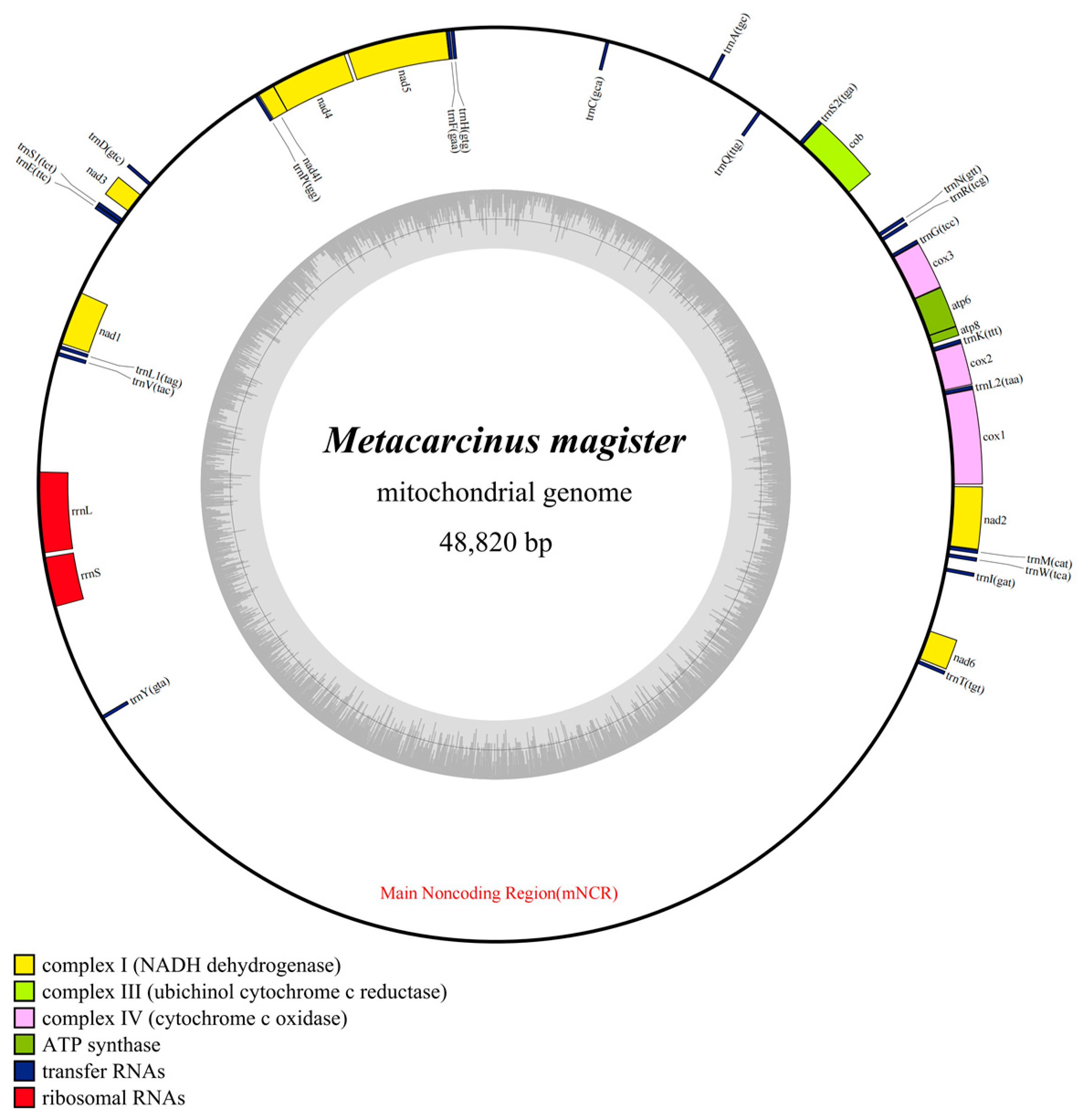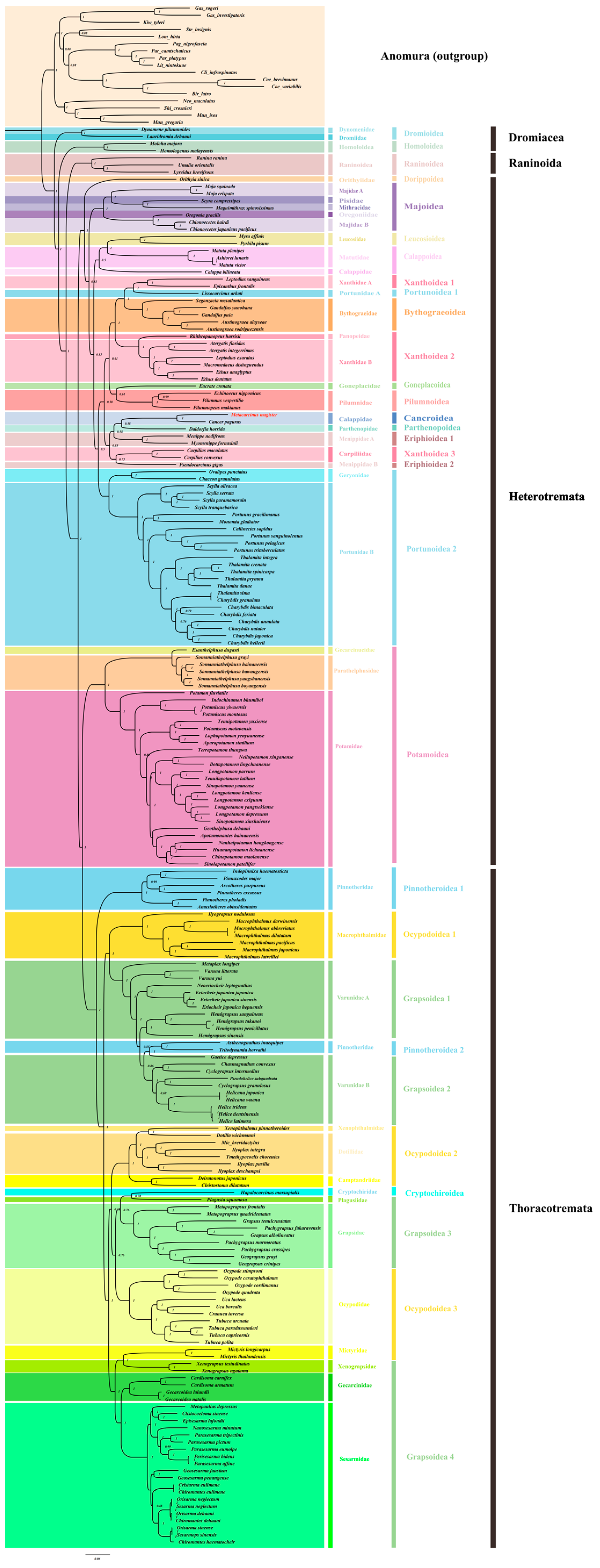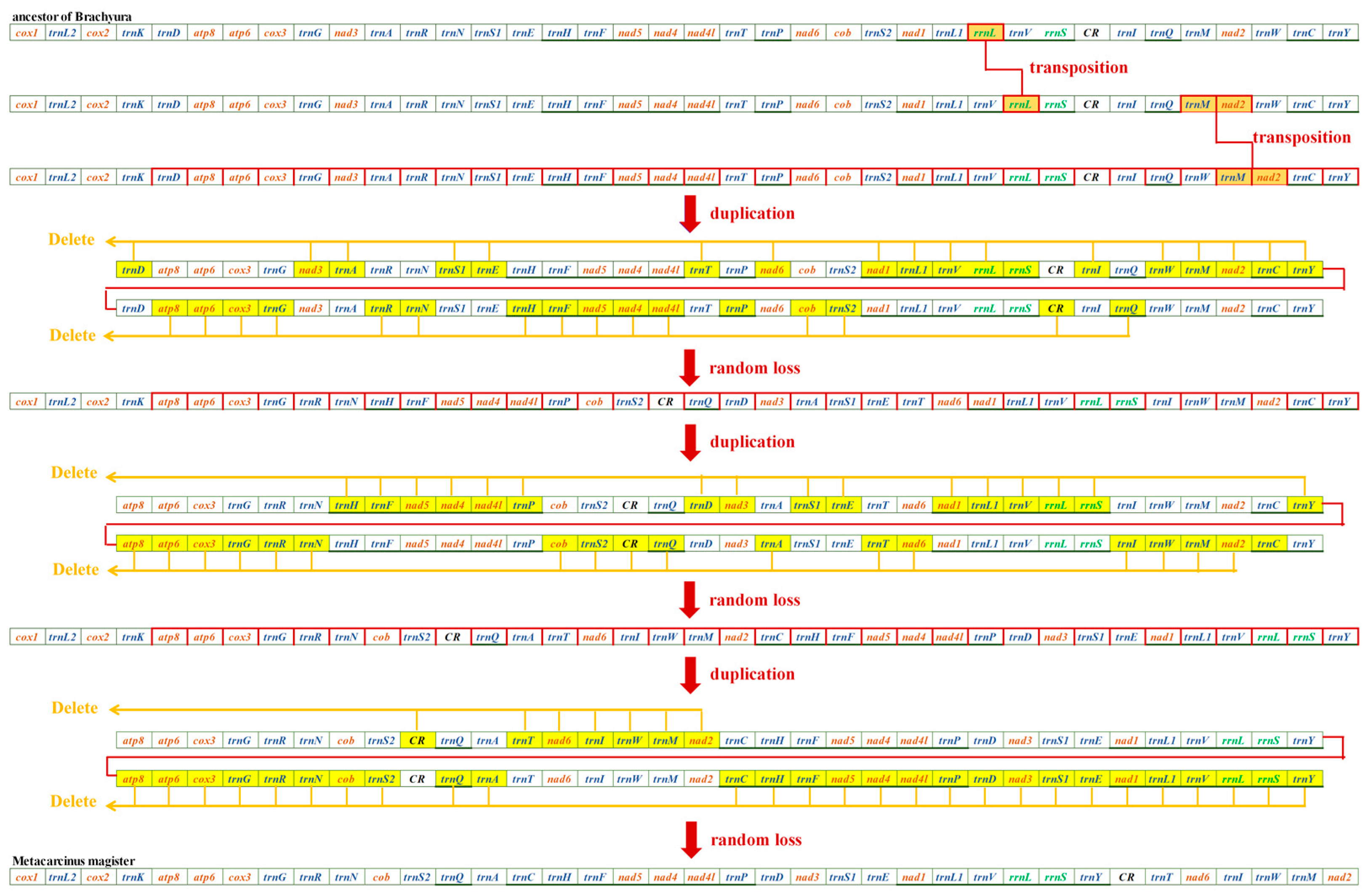Analysis of the Overlength Main Noncoding Region in Metacarcinus magister (Decapoda: Brachyura) and a Phylogenetic Study of the Cancroidea Species
Abstract
:1. Introduction
2. Materials and Methods
2.1. DNA Extraction
2.2. PCR Amplification and Sequencing
2.3. Sequence Analysis and Gene Annotation
2.4. Phylogenetic Analysis
2.5. Gene Rearrangements
3. Results
3.1. Mitogenome Organization and Base Composition
3.2. Skewness
3.3. PCGs and Codon Usage
3.4. Secondary Structure of Transfer and Ribosomal RNAs
3.5. Main Noncoding Region
3.6. Phylogenetic Analysis
3.7. Gene Rearrangements
4. Discussion
4.1. The Particular Mitochondrial Length of M. magister
4.2. Genome Rearrangement in Cancroidea
5. Conclusions
Supplementary Materials
Author Contributions
Funding
Institutional Review Board Statement
Informed Consent Statement
Data Availability Statement
Acknowledgments
Conflicts of Interest
References
- Yang, J.S.; Nagasawa, H.; Fujiwara, Y.; Tsuchida, S.; Yang, W.J. The complete mitogenome of the hydrothermal vent crab Gandalfus yunohana (Crustacea: Decapoda: Brachyura): A link between the Bythograeoidea and Xanthoidea. Zool. Scr. 2010, 39, 621–630. [Google Scholar] [CrossRef]
- Jacobsen, M.W.; Hansen, M.M.; Orlando, L.; Bekkevold, D.; Bernatchez, L.; Willerslev, E.; Gilbert, M.T.P. Mitogenome sequencing reveals shallow evolutionary histories and recent divergence time between morphologically and ecologically distinct European whitefish (Coregonus spp.). Mol. Ecol. 2012, 21, 2727–2742. [Google Scholar] [CrossRef] [PubMed]
- Jayatri, D. The role of mitochondrial respiration in physiological and evolutionary adaptation. BioEssays 2006, 28, 890–901. [Google Scholar]
- Kobayashi, G.; Itoh, H.; Fukuda, H.; Kojima, S. The complete mitochondrial genome of the sand bubbler crab Scopimera globosa and its phylogenetic position. Genomics 2020, 113, 831–839. [Google Scholar] [CrossRef] [PubMed]
- Maduna, S.N.; Vivian-Smith, A.; Jónsdóttir, Ó.D.B.; Imsland, A.K.D.; Klütsch, C.F.C.; Nyman, T.; Eiken, H.G.; Hage, S.B. Mitogenomics of the suborder Cottoidei (Teleostei: Perciformes): Improved assemblies, mitogenome features, phylogeny, and ecological implications. Genomics 2022, 114, 110297. [Google Scholar] [CrossRef]
- Lavrov, D.V.; Walker, P.; Oliver, V.; Gert, W.; Forget, L.; Lang, B.F.; Ehsan, K. Mitochondrial DNA of Clathrina clathrus (Calcarea, Calcinea): Six Linear Chromosomes, Fragmented rRNAs, tRNA Editing, and a Novel Genetic Code. Mol. Biol. Evol. 2012, 4, 865–880. [Google Scholar] [CrossRef]
- Teletchea, F. Molecular identification methods of fish species: Reassessment and possible applications. Rev. Fish Biol. Fish. 2009, 19, 265–293. [Google Scholar] [CrossRef]
- Agarwal, M.; Shrivastava, N.; Padh, H. Advances in molecular marker techniques and their applications in plant sciences. Plant Cell Rep. 2008, 27, 617–631. [Google Scholar] [CrossRef]
- Cavalli-Sforza, L.L.; Feldman, M.W. The application of molecular genetic approaches to the study of human evolution. Nat. Genet. 2003, 33, 266–275. [Google Scholar] [CrossRef]
- Wang, Z.; Wu, Q.; Guo, H.; Tang, D.; Tao, Y. Next-generation sequencing yields the complete mitogenome of Caridina multidentata and phylogenetic analysis. Mitochondrial DNA Part B 2018, 3, 68–70. [Google Scholar] [CrossRef]
- Roe, A.D.; Sperling, F.A.H. Patterns of evolution of mitochondrial cytochrome c oxidase I and II DNA and implications for DNA barcoding. Mol. Phylogenet. Evol. 2007, 44, 325–345. [Google Scholar] [CrossRef] [PubMed]
- Ma, K.Y.; Qin, J.; Lin, C.W.; Chan, T.Y.; Ng, P.K.; Chu, K.H.; Tsang, L.M. Phylogenomic analyses of brachyuran crabs support early divergence of primary freshwater crabs. Mol. Phylogenet. Evol. 2019, 135, 62–66. [Google Scholar] [CrossRef] [PubMed]
- Wang, Y.F.; Yang, Q.; Xu, S.X.; Zhao, M.J.; Zou, J.X. The complete mitochondrial genome of the freshwater crab Bottapotamon lingchuanense Türkay and Dai 1997 (Decapoda: Brachyura: Potamoidea). Mitochondrial DNA Part B 2021, 6, 1554–1556. [Google Scholar] [CrossRef] [PubMed]
- Ji, Y.; Wang, A.; Lu, X.; Song, D.; Jin, Y.; Lu, J.; Sun, H. Mitochondrial genomes of two brachyuran crabs (Crustacea: Decapoda) and phylogenetic analysis. J. Crustac. Biol. 2014, 34, 494–503. [Google Scholar] [CrossRef]
- Karasawa, H.; Schweitzer, C.E. A new classification of the Xanthoidea sensu lato (Crustacea: Decapoda: Brachyura) based on phylogenetic analysis and traditional systematics and evaluation of all fossil Xanthoidea sensu lato. Contrib. Zool. 2006, 75, 23–73. [Google Scholar] [CrossRef]
- Davie, P.J.; Guinot, D.; Ng, P.K. Anatomy and functional morphology of Brachyura. In Treatise On Zoology-Anatomy, Taxonomy, Biology. The Crustacea, Volume 9 Part C (2 Vols); Brill: Leiden, The Netherlands, 2015; pp. 11–163. [Google Scholar]
- Ng, P.K.; Guinot, D.; Davie, P.J. Systema Brachyurorum: Part I. An annotated checklist of extant brachyuran crabs of the world. Raffles Bull. Zool. 2008, 17, 1–286. [Google Scholar]
- Chen, J.; Xing, Y.; Yao, W.; Zhang, C.; Zhang, Z.; Jiang, G.; Ding, Z. Characterization of four new mitogenomes from Ocypodoidea & Grapsoidea, and phylomitogenomic insights into thoracotreme evolution. Gene 2018, 675, 27–35. [Google Scholar] [PubMed]
- Altschul, S.F.; Madden, T.L.; Schäffer, A.A.; Zhang, J.; Zhang, Z.; Miller, W.; Lipman, D.J. Gapped BLAST and PSI-BLAST: A new generation of protein database search programs. Nucleic Acids Res. 1997, 25, 3389–3402. [Google Scholar] [CrossRef] [PubMed]
- Rombel, I.T.; Sykes, K.F.; Rayner, S.; Johnston, S.A. ORF-FINDER: A vector for high-throughput gene identification. Gene 2002, 282, 33–41. [Google Scholar] [CrossRef]
- Bernt, M.; Donath, A.; Jühling, F.; Externbrink, F.; Florentz, C.; Fritzsch, G.; Pütz, J.; Middendorf, M.; Stadler, P.F. MITOS: Improved de novo metazoan mitochondrial genome annotation. Mol. Phylogenet. Evol. 2013, 69, 313–319. [Google Scholar] [CrossRef]
- Tamura, K.; Peterson, D.; Peterson, N.; Stecher, G.; Nei, M.; Kumar, S. MEGA5: Molecular Evolutionary Genetics Analysis Using Maximum Likelihood, Evolutionary Distance, and Maximum Parsimony Methods. Mol. Biol. Evol. 2011, 28, 2731. [Google Scholar] [CrossRef] [PubMed]
- Gan, H.M.; Schultz, M.B.; Austin, C.M. Integrated shotgun sequencing and bioinformatics pipeline allows ultra-fast mitogenome recovery and confirms substantial gene rearrangements in Australian freshwater crayfishes. BMC Evol. Biol. 2014, 14, 19. [Google Scholar] [CrossRef] [PubMed]
- Lohse, M.; Drechsel, O.; Bock, R. OrganellarGenomeDRAW (OGDRAW): A tool for the easy generation of high-quality custom graphical maps of plastid and mitochondrial genomes. Curr. Genet. 2007, 52, 267–274. [Google Scholar] [CrossRef] [PubMed]
- Zuker, M. Mfold Web Server for Nucleic Acid Folding and Hybridization Prediction. Nucleic Acids Res. 2003, 31, 3406–3415. [Google Scholar] [CrossRef]
- Wang, W. The molecular detection of Corynespora Cassiicola on cucumber by PCR assay using DNAman software and NCBI. In Proceedings of the CCTA 2015: Computer and Computing Technologies in Agriculture IX, Beijing, China, 27–30 September 2015; pp. 248–258. [Google Scholar]
- Gary, B. Tandem repeats finder: A program to analyze DNA sequences. Nucleic Acids Res. 1999, 27, 573–580. [Google Scholar]
- Edgar, R.C. MUSCLE: Multiple sequence alignment with high accuracy and high throughput. Nucleic Acids Res. 2004, 28, 1792–1797. [Google Scholar] [CrossRef] [PubMed]
- Ling, C.; Luo, A.; Gao, J. MrBayes 3.2. 6 on Tianhe-1A: A high performance and distributed implementation of phylogenetic analysis. In Proceedings of the 2016 IEEE 22nd International Conference on Parallel and Distributed Systems (ICPADS), Wuhan, China, 13–16 December 2016; pp. 1181–1186. [Google Scholar]
- Alexandros, S. RAxML version 8: A tool for phylogenetic analysis and post-analysis of large phylogenies. Bioinformatics 2014, 30, 1312–1313. [Google Scholar]
- Lam-Tung, N.; Schmidt, H.A.; Arndt, V.H.; Quang, M.B. IQ-TREE: A Fast and Effective Stochastic Algorithm for Estimating Maximum-Likelihood Phylogenies. Mol. Biol. Evol. 2015, 32, 268–274. [Google Scholar]
- Bruyn, A.D.; Martin, D.P.; Lefeuvre, P. Phylogenetic reconstruction methods: An overview. In Molecular Plant Taxonomy; Springer: Berlin/Heidelberg, Germany, 2014; pp. 257–277. [Google Scholar]
- Bernt, M.; Merkle, D.; Kai, R.; Fritzsch, G.; Perseke, M.; Bernhard, D.; Schlegel, M.; Stadler, P.F.; Middendorf, M. CREx: Inferring genomic rearrangements based on common intervals. Bioinformatics 2007, 23, 2957–2958. [Google Scholar] [CrossRef]
- Bernt, M.; Merkle, D.; Middendorf, M. An algorithm for inferring mitogenome rearrangements in a phylogenetic tree. In Proceedings of the Comparative Genomics: International Workshop, RECOMB-CG 2008, Paris, France, 13–15 October 2008; pp. 143–157. [Google Scholar]
- Basso, A.; Babbucci, M.; Pauletto, M.; Riginella, E.; Patarnello, T.; Negrisolo, E. The highly rearranged mitochondrial genomes of the crabs Maja crispata and Maja squinado (Majidae) and gene order evolution in Brachyura. Sci. Rep. 2017, 7, 4096. [Google Scholar] [CrossRef]
- Wang, Q.; Tang, D.; Guo, H.; Wang, J.; Xu, X.; Wang, Z. Comparative mitochondrial genomic analysis of Macrophthalmus pacificus and insights into the phylogeny of the Ocypodoidea & Grapsoidea. Genomics 2020, 112, 82–91. [Google Scholar] [PubMed]
- Rodovalho, C.D.M.; Lyra, M.L.; Ferro, M.; Bacci, M., Jr. The Mitochondrial Genome of the Leaf-Cutter Ant Atta laevigata: A Mitogenome with a Large Number of Intergenic Spacers. PLoS ONE 2014, 9, e97117. [Google Scholar] [CrossRef]
- Pan, D.; Shi, B.; Du, S.; Gu, T.; Wang, R.; Xing, Y.; Zhang, Z.; Chen, J.; Cumberlidge, N.; Sun, H. Mitogenome phylogeny reveals Indochina Peninsula origin and spatiotemporal diversification of freshwater crabs (Potamidae: Potamiscinae) in China. Cladistics 2022, 38, 1–12. [Google Scholar] [CrossRef] [PubMed]
- Zhao, L.; Gao, T.; Lu, W. Complete mitochondrial DNA sequence of the endangered fish (Bahaba taipingensis): Mitogenome characterization and phylogenetic implications. ZooKeys 2015, 546, 181–195. [Google Scholar] [CrossRef]
- Fenn, J.D.; Cameron, S.L.; Whiting, M.F. The complete mitochondrial genome sequence of the Mormon cricket (Anabrus simplex: Tettigoniidae: Orthoptera) and an analysis of control region variability. Insect Mol. Biol. 2010, 16, 239–252. [Google Scholar] [CrossRef] [PubMed]
- Li, Y.T.; Xin, Z.Z.; Tang, Y.Y.; Yang, T.T.; Yu, X.M. Comparative Mitochondrial Genome Analyses of Sesarmid and Other Brachyuran Crabs Reveal Gene Rearrangements and Phylogeny. Front. Genet. 2020, 11, 536640. [Google Scholar] [CrossRef] [PubMed]
- Zhi-Teng, C.; Yu-Zhou, D. First Mitochondrial Genome from Nemouridae (Plecoptera) Reveals Novel Features of the Elongated Control Region and Phylogenetic Implications. Int. J. Mol. Sci. 2017, 18, 996. [Google Scholar] [CrossRef]
- Min, Z.; Nie, X.; Cao, T.; Wang, J.; Tao, L.; Zhang, X.; Guo, Y.; Ma, E.; Yang, Z. The complete mitochondrial genome of the butterfly Apatura metis (Lepidoptera: Nymphalidae). Mol. Biol. Rep. 2012, 39, 6529–6536. [Google Scholar]
- Spiridonov, V.A.; Neretina, T.V.; Schepetov, D. Morphological characterization and molecular phylogeny of Portunoidea Rafinesque, 1815 (Crustacea Brachyura): Implications for understanding evolution of swimming capacity and revision of the family-level classification. Zool. Anz. J. Comp. Zool. 2014, 253, 404–429. [Google Scholar] [CrossRef]
- Stokkan, M.; Jurado-Rivera, J.A.; Juan, C.; Jaume, D.; Pons, J. Mitochondrial genome rearrangements at low taxonomic levels: Three distinct mitogenome gene orders in the genus Pseudoniphargus (Crustacea: Amphipoda). Mitochondrial DNA 2016, 27, 3579–3589. [Google Scholar] [CrossRef]
- Tan, M.H.; Gan, H.M.; Yin, P.L.; Linton, S.; Austin, C.M. ORDER within the chaos: Insights into phylogenetic relationships within the Anomura (Crustacea: Decapoda) from mitochondrial sequences and gene order rearrangements. Mol. Phylogenet. Evol. 2018, 127, 320. [Google Scholar] [CrossRef] [PubMed]
- Lu, X.; Gong, L.; Zhang, Y.; Chen, J.; Liu, L.; Jiang, L.; Lü, Z.; Liu, B.; Tong, G.; Wei, X. The complete mitochondrial genome of Calappa bilineata: The first representative from the family Calappidae and its phylogenetic position within Brachyura. Genomics 2020, 112, 2516–2523. [Google Scholar] [CrossRef] [PubMed]
- Du, S.; Pan, D.; Zhang, K.; Liu, C.; Yin, J.; Cumberlidge, N.; Sun, H. A novel gene order and remolded tRNAs revealed in the mitogenome of Asian gecarcinucid freshwater crabs (Brachyura, Gecarcinucidae). Gene 2021, 813, 146102. [Google Scholar] [CrossRef] [PubMed]
- Wang, Z.; Shi, X.; Tao, Y.; Wu, Q.; Bai, Y.; Guo, H.; Dan, T. The complete mitochondrial genome of Parasesarma pictum (Brachyura: Grapsoidea: Sesarmidae) and comparison with other Brachyuran crabs. Genomics 2019, 111, 799–807. [Google Scholar] [CrossRef]
- Rasmuson, L.K. The biology, ecology and fishery of the dungeness crab, cancer magister. Adv. Mar. Biol. 2013, 65, 95–148. [Google Scholar]




| Gene | Direction | Location | Size | Anticodon | Start Codon | Stop Codon | Intergenic |
|---|---|---|---|---|---|---|---|
| cox1 | + | 1–1534 | 1534 | ATG | T | −5 | |
| trnL2 | + | 1535–1598 | 64 | TAA | 8 | ||
| cox2 | + | 1607–2294 | 688 | ATG | T | 0 | |
| trnK | + | 2295–2361 | 67 | TTT | 56 | ||
| atp8 | + | 2418–2576 | 159 | ATG | TAG | −7 | |
| atp6 | + | 2570–3244 | 675 | GTG | TAA | −1 | |
| cox3 | + | 3244–4034 | 791 | ATG | TA | −1 | |
| trnG | + | 4034–4097 | 64 | TCC | 259 | ||
| trnR | + | 4357–4422 | 66 | TCG | 28 | ||
| trnN | + | 4451–4519 | 69 | GTT | 849 | ||
| cob | + | 5369–6506 | 1138 | ATG | T | 0 | |
| trnS2 | + | 6507–6573 | 67 | TGA | 812 | ||
| trnQ | − | 7386–7454 | 69 | TTG | 931 | ||
| trnA | + | 8386–8450 | 65 | TGC | 1799 | ||
| trnC | − | 10,250–10,315 | 66 | GCA | 2593 | ||
| trnH | − | 12,909–12,974 | 66 | GTG | 8 | ||
| trnF | − | 12,983–13,046 | 64 | GAA | 0 | ||
| nad5 | − | 13,047–14,775 | 1729 | ATG | T | 53 | |
| nad4 | − | 14,829–16,163 | 1335 | ATG | TAA | −7 | |
| nad4l | − | 16,157–16,453 | 297 | ATG | TAA | 6 | |
| trnP | − | 16,460–16,527 | 68 | TGG | 2295 | ||
| trnD | + | 18,823–18,886 | 64 | GTC | 204 | ||
| nad3 | + | 19,091–19,444 | 354 | ATC | TAA | 152 | |
| trnS1 | + | 19,597–19,663 | 67 | TCT | 0 | ||
| trnE | + | 19,664–19,729 | 66 | TTC | 1307 | ||
| nad1 | − | 21,037–21,975 | 939 | GTG | TAA | 27 | |
| trnL1 | − | 22,003–22,071 | 69 | TAG | 47 | ||
| trnV | − | 22,119–22,191 | 73 | TAC | 1997 | ||
| rrnL | − | 24,189–25,584 | 1396 | 67 | |||
| rrnS | − | 25,652–26,518 | 867 | 2012 | |||
| trnY | − | 28,531–28,601 | 71 | GTA | 0 | ||
| mNCR | + | 28,602–45,698 | 17,097 | 0 | |||
| trnT | + | 45,699–45,764 | 66 | TGT | 25 | ||
| nad6 | + | 45,790–46,296 | 507 | ATT | TAA | 1039 | |
| trnI | + | 47,336–47,402 | 67 | GAT | 179 | ||
| trnW | + | 47,582–47,649 | 68 | TCA | 58 | ||
| trnM | + | 47,708–47,773 | 66 | CAT | 0 | ||
| nad2 | + | 47,774–48,790 | 1017 | ATG | TAA | 30 |
| M. magister | T (U) (%) | C (%) | A (%) | G (%) | A + T (%) | AT-Skew | GC-Skew |
|---|---|---|---|---|---|---|---|
| Mitogenome | 34.72 | 22.34 | 33.97 | 8.97 | 68.69 | −0.01 | −0.43 |
| PCGs | 39.28 | 17.26 | 26.53 | 16.93 | 65.81 | −0.19 | −0.01 |
| cox1 | 36.52 | 20.92 | 26.06 | 16.50 | 62.57 | −0.17 | −0.12 |
| cox2 | 35.78 | 20.23 | 30.06 | 13.93 | 65.84 | −0.09 | −0.18 |
| atp8 | 43.40 | 19.50 | 28.93 | 8.18 | 72.33 | −0.20 | −0.41 |
| atp6 | 38.69 | 21.43 | 27.08 | 12.80 | 65.77 | −0.18 | −0.25 |
| cox3 | 36.11 | 22.66 | 25.35 | 15.88 | 61.46 | −0.18 | −0.18 |
| cob | 38.27 | 21.47 | 25.97 | 14.29 | 64.24 | −0.19 | −0.20 |
| nad5 | 39.08 | 10.36 | 27.83 | 22.74 | 66.90 | −0.17 | 0.37 |
| nad4 | 42.25 | 9.74 | 26.74 | 21.27 | 68.99 | −0.22 | 0.37 |
| nad4l | 42.42 | 8.75 | 25.59 | 23.23 | 68.01 | −0.25 | 0.45 |
| nad3 | 38.38 | 19.89 | 28.29 | 13.45 | 66.67 | −0.15 | −0.19 |
| nad1 | 42.74 | 10.47 | 24.15 | 22.65 | 66.88 | −0.28 | 0.37 |
| nad6 | 41.52 | 23.78 | 25.93 | 8.77 | 67.45 | −0.23 | −0.46 |
| nad2 | 40.71 | 23.50 | 25.37 | 10.42 | 66.08 | −0.23 | −0.39 |
| tRNAs | 34.04 | 12.64 | 36.55 | 16.78 | 70.58 | 0.04 | 0.14 |
| rRNAs | 34.42 | 9.72 | 38.75 | 17.10 | 73.18 | 0.06 | 0.28 |
| mNCR | 29.72 | 27.02 | 33.77 | 9.50 | 63.48 | 0.06 | −0.48 |
Disclaimer/Publisher’s Note: The statements, opinions and data contained in all publications are solely those of the individual author(s) and contributor(s) and not of MDPI and/or the editor(s). MDPI and/or the editor(s) disclaim responsibility for any injury to people or property resulting from any ideas, methods, instructions or products referred to in the content. |
© 2024 by the authors. Licensee MDPI, Basel, Switzerland. This article is an open access article distributed under the terms and conditions of the Creative Commons Attribution (CC BY) license (https://creativecommons.org/licenses/by/4.0/).
Share and Cite
Wang, Z.; Xu, X.; Zheng, Y.; Xu, Z.; Li, Y.; Chen, H. Analysis of the Overlength Main Noncoding Region in Metacarcinus magister (Decapoda: Brachyura) and a Phylogenetic Study of the Cancroidea Species. Genes 2024, 15, 437. https://doi.org/10.3390/genes15040437
Wang Z, Xu X, Zheng Y, Xu Z, Li Y, Chen H. Analysis of the Overlength Main Noncoding Region in Metacarcinus magister (Decapoda: Brachyura) and a Phylogenetic Study of the Cancroidea Species. Genes. 2024; 15(4):437. https://doi.org/10.3390/genes15040437
Chicago/Turabian StyleWang, Zhengfei, Xinyi Xu, Yuqing Zheng, Zhiwen Xu, Yunjie Li, and Huohuo Chen. 2024. "Analysis of the Overlength Main Noncoding Region in Metacarcinus magister (Decapoda: Brachyura) and a Phylogenetic Study of the Cancroidea Species" Genes 15, no. 4: 437. https://doi.org/10.3390/genes15040437





